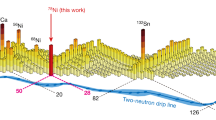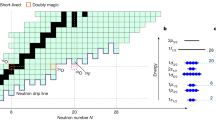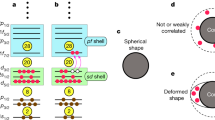Abstract
Nuclear shell structures—the distribution of the quantum states of individual protons and neutrons—provide one of our most important guides for understanding the stability of atomic nuclei. Nuclei with ‘magic numbers’ of protons and/or neutrons (corresponding to closed shells of strongly bound nucleons) are particularly stable1,2. Whether the major shell closures and magic numbers change in very neutron-rich nuclei (potentially causing shape deformations) is a fundamental, and at present open, question3,4. A unique opportunity to study these shell effects is offered by the 42Si nucleus, which has 28 neutrons—a magic number in stable nuclei—and 14 protons. This nucleus has a 12-neutron excess over the heaviest stable silicon nuclide, and has only one neutron fewer than the heaviest silicon nuclide observed so far5. Here we report measurements of 42Si and two neighbouring nuclei using a technique involving one- and two-nucleon knockout from beams of exotic nuclei6,7. We present strong evidence for a well-developed proton subshell closure at Z = 14 (14 protons), the near degeneracy of two different (s1/2 and d3/2) proton orbits in the vicinity of 42Si, and a nearly spherical shape for 42Si.
This is a preview of subscription content, access via your institution
Access options
Subscribe to this journal
Receive 51 print issues and online access
$199.00 per year
only $3.90 per issue
Buy this article
- Purchase on Springer Link
- Instant access to full article PDF
Prices may be subject to local taxes which are calculated during checkout




Similar content being viewed by others
References
Mayer, M. G. On closed shells in nuclei II. Phys. Rev. 75, 1969–1970 (1949)
Haxel, O., Jensen, J. H. D. & Suess, H. E. On the “magic numbers” in nuclear structure. Phys. Rev. 75, 1766 (1949)
Nazarewicz, W. & Casten, R. F. Physics at the Rare Isotope Accelerator (RIA): Exploring the nuclear landscape. Nucl. Phys. A 682, 295c–309c (2001)
Warner, D. Not-so-magic numbers. Nature 430, 517–519 (2004)
Notani, M. et al. New neutron-rich isotopes, 34Ne, 37Na and 43Si, produced by fragmentation of a 64 A MeV 48Ca beam. Phys. Lett. B 542, 49–54 (2002)
Hansen, P. G. & Tostevin, J. A. Direct reactions with exotic nuclei. Annu. Rev. Nucl. Part. Sci. 53, 219–261 (2003)
Bazin, D. et al. New direct reaction: Two-proton knockout from neutron-rich nuclei. Phys. Rev. Lett. 91, 012501 (2003)
Werner, T. R. et al. Shape coexistence around 4416S28: The deformed N = 28 region. Phys. Lett. B 333, 303–309 (1994)
Werner, T. R. et al. Ground-state properties of exotic Si, S, Ar and Ca isotopes. Nucl. Phys. A 597, 327–340 (1996)
Terasaki, J., Flocard, H., Heenen, P.-H. & Bonche, P. Deformation of nuclei close to the two-neutron drip line in the Mg region. Nucl. Phys. A 621, 706–718 (1997)
Lalazissis, G. A., Farhan, A. R. & Sharma, M. M. Light nuclei near neutron and proton drip lines in relativistic mean-field theory. Nucl. Phys. A 628, 221–254 (1998)
Lalazissis, G. A., Vretenar, D., Ring, P., Stoitsov, M. & Robledo, L. M. Relativistic Hartree + Bogoliubov description of the deformed N = 28 region. Phys. Rev. C 60, 014310 (1999)
Peru, S., Girod, M. & Berger, J. F. Evolution of the N = 20 and N = 28 shell closures in neutron-rich nuclei. Eur. Phys. J. A 9, 35–47 (2000)
Rodriguez-Guzman, R., Egido, J. L. & Robledo, L. M. Quadrupole collectivity in N ≈ 28 nuclei with the angular momentum projected generator coordinate method. Phys. Rev. C 65, 024304 (2002)
Grevy, S. et al. Beta-decay half-lives at the N = 28 shell closure. Phys. Lett. B 594, 252–259 (2004)
Cottle, P. D. & Kemper, K. W. Persistence of the N = 28 shell closure in neutron-rich nuclei. Phys. Rev. C 58, 3761–3762 (1998)
Caurier, E., Nowacki, F. & Poves, A. The N = 28 shell closure: from N = Z to the neutron drip line. Nucl. Phys. A 742, 14–26 (2004)
Morrissey, D. J. et al. Commissioning the A1900 projectile fragment separator. Nucl. Instrum. Methods Phys. Res. B 204, 90–96 (2003)
Bazin, D. et al. The S800 spectrograph. Nucl. Instrum. Methods Phys. Res. B 204, 629–633 (2003)
Mueller, W. F. et al. Thirty-two-fold segmented germanium detectors to identify γ-rays from intermediate-energy exotic beams. Nucl. Instrum. Methods Phys. Res. A 466, 492–498 (2001)
Tostevin, J. A. Single-nucleon knockout reactions at fragmentation beam energies. Nucl. Phys. A 682, 320c–331c (2001)
Gade, A. et al. One-neutron knockout reactions on proton-rich nuclei with N = 16. Phys. Rev. C 69, 034311 (2004)
Nummela, S. et al. Spectroscopy of 34,35Si by β-decay: sd-fp shell gap and single-particle states. Phys. Rev. C 63, 044316 (2001)
Brown, B.A. et al. OXBASH for Windows (MSU-NSCL report number 1289, National Superconducting Cyclotron Laboratory, Michigan State University, East Lansing, Michigan, 2004).
Duflo, J. & Zuker, A. P. The nuclear monopole Hamiltonian. Phys. Rev. C 59, R2347 (1999)
Doll, P. et al. The quasihole aspect of hole strength distributions in odd potassium and calcium isotopes. Nucl. Phys. A 263, 210–236 (1976)
Schiffer, J. P. et al. Is the nuclear spin-orbit interaction changing with neutron excess? Phys. Rev. Lett. 92, 162501 (2004)
Tostevin, J. A., Podolyak, G., Brown, B. A. & Hansen, P. G. Correlated two-nucleon stripping reactions. Phys. Rev. C 70, 064602 (2004)
Acknowledgements
We acknowledge the support of the US National Science Foundation and the US Department of Energy.
Author information
Authors and Affiliations
Corresponding author
Ethics declarations
Competing interests
Reprints and permissions information is available at npg.nature.com/reprintsandpermissions. The authors declare no competing financial interests.
Rights and permissions
About this article
Cite this article
Fridmann, J., Wiedenhöver, I., Gade, A. et al. ‘Magic’ nucleus 42Si. Nature 435, 922–924 (2005). https://doi.org/10.1038/nature03619
Received:
Accepted:
Issue Date:
DOI: https://doi.org/10.1038/nature03619
This article is cited by
-
Spin–orbit splitting of protons and neutrons
Pramana (2023)
-
Study of weakening of shell N = 28 for neutron rich nuclei through particle number fluctuation and pairing energy
Indian Journal of Physics (2017)
-
Unexpectedly large charge radii of neutron-rich calcium isotopes
Nature Physics (2016)
-
Nanostructured organosilicon luminophores and their application in highly efficient plastic scintillators
Scientific Reports (2014)
-
Fat silicon atoms are doubly magic
Nature (2005)
Comments
By submitting a comment you agree to abide by our Terms and Community Guidelines. If you find something abusive or that does not comply with our terms or guidelines please flag it as inappropriate.



